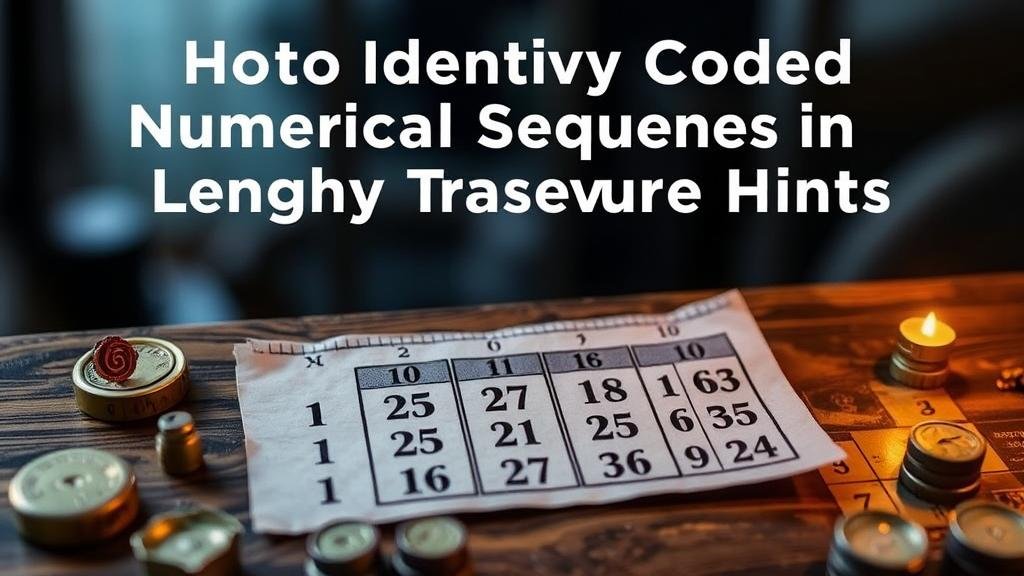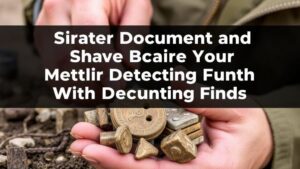How to Identify Coded Numerical Sequences in Lengthy Treasure Hints
How to Identify Coded Numerical Sequences in Lengthy Treasure Hints
Treasure hunting has captivated human imagination for centuries, not only as a thrilling venture but also as an intellectual exercise in decoding clues. One of the most intriguing challenges lies in identifying coded numerical sequences within lengthy treasure hints. These sequences often serve as critical pathways to uncovering hidden locations or items of great value. This article outlines a systematic approach to decoding these numerical sequences, supplemented by concrete examples and practical applications.
Understanding Coded Numerical Sequences
Coded numerical sequences are patterns embedded within hints that may use numbers for direct indication or as parts of a more complex encoding system. Such codes can range from simple ciphers to intricate numeric systems that can be applied in various contexts, similar to the way numerical codes in mathematical puzzles function. A solid understanding of these sequences requires familiarity with various coding techniques.
Common Coding Techniques
There are several widely recognized techniques used to encode numerical sequences, and understanding them can greatly assist in deciphering treasure hints. Some common techniques include:
- Substitution Ciphers: These involve replacing each number with another digit or character. For example, in a simple substitution cipher, the number 1 might be replaced by 3, resulting in the sequence {3, 5, 7} representing the coded numbers {1, 3, 5}.
- Pattern Recognition: Many codes use patterns–such as Fibonacci sequences or prime numbers. Recognizing such patterns can provide insight into the meaning behind the numbers.
- Mathematical Operations: Sometimes, clues involve performing operations such as addition or multiplication on the numbers presented. For example, if a treasure hint says add 4 to 7, the outcome (11) may represent a crucial location or numeric code.
Step-by-Step Methodology for Decoding
Decoding a lengthy treasure hint with numerical sequences can be daunting, but a step-by-step approach can help simplify the process. Below is a recommended methodology:
Step 1: Initial Review
The first step involves conducting an initial review of the hint to identify potential numerical sequences. Look for strings of numbers, as well as words that may suggest quantifiable values, such as three, ten, or fifty.
Step 2: Identify Patterns
Once identified, write down the numerical sequences separately. Analyze these sequences for any apparent patterns, whether they follow a mathematical rule, a substitution pattern, or resemble known sequences like prime numbers or multiples of a specific value.
Step 3: Cross-reference with Known Codes
Use existing knowledge of coded languages and historical codes to cross-reference the sequences youve noted. Many treasure hunting communities have developed databases of clues and their corresponding codes, which can often provide valuable insights.
Step 4: Apply Logical Deductions
Logic plays an essential role in decoding. For example, if the numerical sequence leads you to believe a location or object is at a specific coordinate, use deduction to validate this with geographic or historical data.
Step 5: Test Hypotheses
Once you form hypotheses based on your deductions, testing them at the location or within the context of the treasure hint is crucial. This may involve a trial-and-error approach where you attempt different derived locations or solutions until finding a match.
Real-World Case Studies
One of the most famous examples of numerical decoding in treasure hunting comes from the “Beale Ciphers,†a series of three encrypted messages that allegedly describe the location of a buried treasure in Virginia. The second cipher, consisting of numerical sequences, is particularly notable. After extensive analysis, decipherers discovered that the sequence reflected word positions in the Declaration of Independence. This case highlights not only the importance of pattern recognition but also the value of historical context in decoding numerical hints.
Practical Applications Beyond Treasure Hunting
The ability to identify coded numerical sequences extends beyond treasure hunting into various fields such as cryptology, data analysis, and even gaming. In cryptography, understanding sequence patterns can protect information against unauthorized access. In the realm of data analytics, analyzing numerical sequences can inform predictions about consumer behavior, leading to more effective marketing strategies.
Conclusion
Identifying coded numerical sequences in lengthy treasure hints requires a systematic approach combining analytical skills, pattern recognition, and a keen understanding of coding techniques. By following a structured methodology, treasure hunters can navigate the exhilarating world of hidden clues with greater confidence. With the right tools and knowledge, unlocking these mysteries can lead not only to tangible rewards but also to a deeper appreciation of the analytical process itself.
Actionable Takeaways
To effectively identify coded numerical sequences in treasure hints:
- Familiarize yourself with common coding techniques and their characteristics.
- Practice your analytical skills through puzzles and historical codes.
- Engage with treasure hunting communities for shared insights and resources.
By applying these strategies consistently, you can enhance your decoding proficiency and optimize your treasure hunting experiences.



